#material handling software
Explore tagged Tumblr posts
Text

#system software india#industrial automation industry pune#automation systems india#material handling systems pune
0 notes
Text
AAAAAAAAAAAAAAA finished first sem. I have jury evaluation in 4 weeks.
#okay rant#all my seniors kept saying that material handling was the most tiring and work heavy course in the entire semester#but it was actually the easiest and had the least workload in the entire semester wtf#like i had so much free time#especially for plaster of paris#anyways i have to learn softwares now#preferably rhino#but I bought a character design course instead
1 note
·
View note
Text
AI, Plagiarism, and CYA
Shout-out for all the students gearing up to go back to school in increasingly frustrated times when dealing with all this AI bullshit. As you've probably noticed, lots of institutions have adapted anti-plagiarism software that incorporates AI detectors that - surprise - aren't that great. Many students are catching flack for getting dinged on work that isn't AI generated, and schools are struggling to catch up to craft policies that uphold academic rigor. It sucks for everyone involved!
As a student, it can really feel like you're in a bind, especially if you didn't do anything wrong. Your instructor isn't like to be as tech-savvy as some, and frankly, you might not be as tech-savvy as you think either. The best thing to do, no matter how your school is handling things, is to Cover Your Ass.
Pay attention to the academic policy. Look, I know you probably skimmed the syllabus. Primus knows I did too, but the policy there is the policy the instructor must stick with. If the policy sets down a strong 'don't touch ChatGPT with a ten-foot pole' standard, stick to it. If you get flagged for something you thought was okay because you didn't read the policy carefully, you don't have ground to stand on if you get called out.
Turn off Autosave and save multiple (named) drafts. If you're using Microsoft Word because your school gives you a free license, the handy Autosave feature may be shooting you in the foot when it comes to proving you did the work. I know this seems counter-intuitive, but I've seen this bite enough people in the ass to recommend students go old-school. Keep those "draft 1234" in a file just in case.
Maintaining timestamped, clearly different drafts of a paper can really help you in the long-run. GoogleDocs also goes a much better job of tracking changes to a document, and may be something to consider, however, with all this AI shit, I'm hesitant to recommend Google. Your best bet, overall, is to keep multiple distinctive drafts that prove how your paragraphs evolved from first to final.
Avoid Grammarly, ProWiritingAid, etc. All that handy 'writing tools' software that claims to help shore up your writing aren't doing you any favors. Grammarly, ProWritingAid, and other software throw up immediate flags in AI-detection software. You may have only used it to clean up the grammar and punctuation, but if the AI-detection software says otherwise, you might be screwed. They're not worth using over a basic spell and grammar check in both Word and GoogleDocs can already do.
Cite all citations and save your sources! This is basic paper-writing, but people using ChatGPT for research often neglect to check to make sure it isn't making shit up, and that made up shit is starting to appear on other parts of the internet. Be sure to click through and confirm what you're using for your paper is true. Get your sources and research material from somewhere other than a generative language model, which are known for making shit up. Yes, Wikipedia is a fine place to start and has rigorously maintained sources.
Work with the support your school has available. My biggest mistake in college was not reaching out when I felt like I was drowning, and I know how easy it is to get in you head and not know where to turn when you need more help. But I've since met a great deal of awesome librarians, tutors, and student aid staff that love nothing more to devote their time to student success. Don't wait at the last moment until they're swamped - you can and will succeed if you reach out early and often.
I, frankly, can't wait for all this AI bullshit to melt down in a catastrophic collapse, but in the meantime, take steps to protect yourself.
#school#AI Bullshit#frankly AI-checkers are just as bad as AI#you gotta take steps to document what you're doing
462 notes
·
View notes
Text

COLORING + SHARPENING TUTORIAL
someone asked for a coloring tutorial and my sharpening settings, so here it is! there are also a few tips to achieve more HQ gifs. :)
tutorial under the cut!
FOR HIGH-QUALITY GIFS
FILE SIZES
it doesn’t matter what your sharpening settings are if the file you’re using to gif is too low quality, so i tend to look for the best that i can get when downloading stuff.
usually, movies (+2h) look better if they’re 5GB or more, while an episode (40 min/1h) can look good with even 1GB. the minimum definition i try to find is 1080p, but i gif with 2160p (4k) when available. unfortunately, not every computer can handle 4k, but don’t worry, you can gif with 1080p files just fine if they are big enough. contrary to popular belief, size does matter! which means sometimes a bigger 1080p file is better than a smaller 2160p one, for example.
SCREENCAPPING METHOD
this can too influence the quality of your gifs. as a gifmaker, i’ve tried it all: video frames to layers, directly opening video clips, loading files into stack, and i’ve finally settled down with opening screencaps as an image sequence. with bigger files, it doesn’t matter much what technique you use, but i’ve noticed with smaller files you can do wonders if you screencap (either by loading files into stack or opening as an image sequence) instead of using video clips. for example, this gif’s original video file was only 4GB (so smaller than i’ve usually go for), if you can believe it!
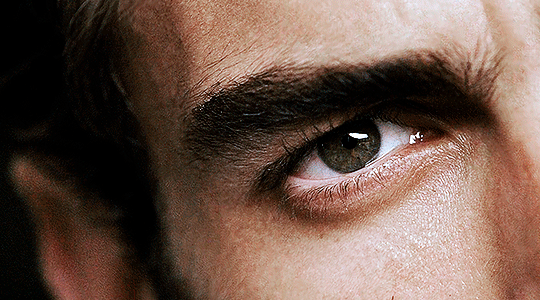
here’s a tutorial for setting up and screencapping with MPV, the media player i use to screencap. again, you can keep using video clips for bigger files, but you’ll find this useful when dealing with dire causes. i don't file loads into stack, though, like the video does. i open as an image sequence (open > screencap folder > select any image > click the image sequence button). just select OK for the speed. this will open your screencaps as a video clip (blue bar) in timeline mode (i'm a timeline gifmaker, i don't know about you). you will need this action pack to convert the clip into frames if you're a frames gifmaker. i suggest you convert them into frames even if you're a timeline gifmaker, just convert them into a timeline again at the end. that way you can delete the screencaps right away, otherwise you will delete the screencaps and get a static image as a "gif".

ATTENTION if you’re a Mac Sonoma user, MPV won’t be an option for you unless you downgrade your system. that is, if you have an Intel chip. if you have M1 Max chip (or even a better one), here’s a fix for MPV you can try while keeping that MacOS, because nowadays MPV is skipping frames in its latest build. or you can use MPlayer instead for less hassle. here are two tutorials for setting and using MPlayer. Windows users are fine, you can use MPV without trouble.
FOR EVEN MORE QUALITY
ADD NOISE
here’s a tutorial for adding noise as a way to achieve more HQ gifs if your original material is too low quality.
REDUCE NOISE WITH CAMERA RAW
instead of adding noise, you can reduce it, especially if your gif is very noisy as it is.
the path is filter > camera raw > detail > nose reduction. i do this before sharpening, but only my video file isn't great to begin with. because it’s a smart filter, you can reduce or increase its opacity by clicking the bars next to its name in the layers panel.
TOPAZ AI
i use Topaz Photo AI to increase the quality of my screencaps when i need to. it’s paid software, but there are… ways to find it for free, usually on t0rrent websites. if someone’s interested, i can make a tutorial solely about it in the future.
SHARPENING SETTINGS
here are my sharpening settings (filter > sharpen > smart sharpen). i sharpen things twice: 500% 0.4px + 10% 10px. here's an action for it, for more convenience. here's a tutorial on how to use Photoshop actions. for animated stuff, i use this action pack.

COLORING
here’s the gif i'm gonna use as a base. it’s already sharpened like the way i always do it.

LIGHTNING THE SHOTS
half of the secret of a good coloring is good lightning. i always useCurves (layers > new adjustment layer > curves) and Brightness & Contrast (layers > new adjustment layer > brightness & contrast). the settings depend on the scene you’re giffing, but i always try make my gifs bright and with high contrast to make the colors pop.
CURVES
besides lighting your scene, the Curves adjustment layer has four automatic options that will color-correct it for you. it’s not always perfect and it doesn’t mean you won’t need to do further coloring, but it’s a great start. it’s a lifesaver for most ridiculously yellow scenes. look at the difference! this gif uses the 3rd automatic option (the screenshot below isn't mine btw so that's why the fourth option is the chosen one), from top to bottom. what automatic option you need to choose depends on the gif.

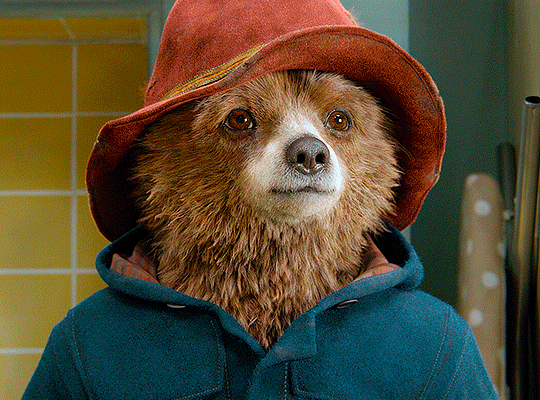


sometimes i like to tweak my Curves layer. not everybody does that, it’s not that necessary and if you’re not careful, it can screw your gif up. to modify your layer by hand, you will need to click and drag points of that straight line in the position you desire. this is the concept behind it:

basically, the lower part of the line handles the shadows, while the upper part handles the highlights of the image. if you pull a highlight point up, the image’s highlights will be brighter. if you pull it down, it will make them darker. same thing for the shadow points. you should play with it to get a grasp of it, that’s what i did when i first started giffing.
BRIGHTNESS & CONTRAST
then i added a bit of brightness and contrast.

CHANNEL MIXER
the scene looked a bit too yellow, so i used the Channel Mixer (layer > new adjustment layer > channel mixer) adjustment layer. here’s a tutorial of how it works. not every scene needs the Channel Mixer layer though, i mostly use it to remove heavy overall tints. in this particular case, the Curves layer got rid of most of the yellow, but i wanted the gif to be just a bit more blue so the Channel Mixer tweaks are very minimal.

SELECTIVE COLOR
now, this adjustment layer i always use: Selective Color (layer > new adjustment layer > selective color). this is THE adjustment layer to me, alongside the Curves one. this is how it works:

ie, you can separately edit a color this way, giving it tints. for this gif, i wanted to make the colors more vibrant. to achieve that, i edited the selected colors this way:
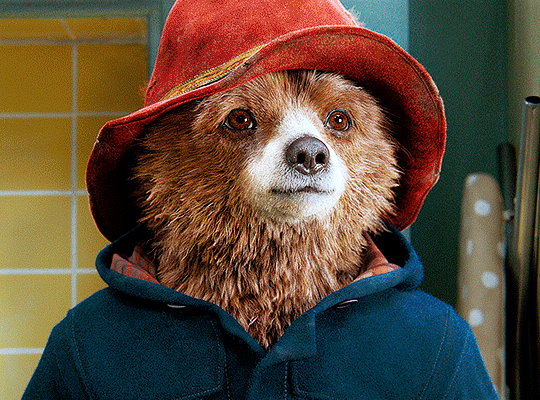
for the reds, i added even more red in them by moving the first slider to the right, making the color more vibrant. for his hat to have a more warm tint, i added yellow to the reds (third slider, moving it to the right). finally, to make the reds stronger, i moved the last slider to the right (more black).
for the yellows, i made them brighter by adding white to them, thus making the tile wall and Paddington more bright as well.
for the cyans and the blues, i just added the maximum (+100) of black that i could.
i wanted for Paddington's nose to be brighter, so i added more white to the whites.
lastly, i added depth to the blacks by increasing their own blackness.
you should always play with the Selective Colors sliders for a bit, before deciding what you want or need. with time, you will automatically know what to change to correct the color grading. it all takes practice!
HUE/SATURATION
i don’t know if you noticed, but there are some green spots on the blue wall behind Paddington. to correct that, i added a Hue/Saturation adjustment layer (layer > new adjustment layer > hue/saturation) and made the saturation of the greens 0%, making that unwanted green disappear from the background.

while the green spots on the wall are specific for this gif, i use hue/saturation a lot to tweak, well, hue and saturation. sometimes someone’s skin is too yellow, i made it redder by tweaking the reds and the yellows, or vice-versa. the hue bar follows the rainbow bar, so the maximum settings (+100 and -100) give the selected color to change its hue to something more red or pink (the rainbow extremities). changing hue can give pretty whacky results, like turning someone’s skin tone to green, so you will need to play with it to get the hang of it. you can also tweak the opacity of your hue/saturation layer to further improve your gif’s coloring. i didn’t do it in this case, the opacity is still 100%. the reds and the blues had their saturation increased to make them pop just a bit more, without affecting the other colors.
COLOR BALANCE
the highlights of the gif still had a green tint to it due to the automatic correction of the Curves layer, so i used Color Balance. this is how it works: instead of giving specific colors some tints, you can give them to the shadows, highlights, and mid-tones. if your shadows are too blue, you counterbalance them with the opposite color, yellow. same thing with the cyan-red and magenta-green pairings. in my case, i added a bit of magenta.


B&W GRADIENT MAP
now, if this gif was a dish, it’s time for the salt and pepper. i always add a Gradient Map (layer > new adjustment layer > gradient map) (black to white gradient) with the Soft Light blending mode, thus giving my shadows more depth without messing with the mid-tones and highlights. it also doesn’t “deep fry” (you know those memes?) the gif too much by adding even more contrast. usually, the opacity of the layer is between 30% to 70%, it all depends on the gif. it always does wonders, though!

COLOR FILTER
finally, i like to add Color Filters (layer > new adjustment layer > color filter) to my gifs. it’s very handy when giving different scenes for the same minimalistic set because it makes them kind of match despite having completely different colors. in this gif’s case, i added a “deep blue” filter, opacity 50% density 25. you can change the density and the opacity of the layer for further editing, again, it all depends on the gif.



VIBRANCE
if i feel like it, i add a vibrance layer (layer > new adjustment layer > vibrance) to make the colors pop. this can ruin your coloring sometimes, especially when regarding skin color, so be careful. i didn't do it in this gif because i felt i didn't need it.
TA-DA! 🥳
AN OTHER EXAMPLE
the color grading of the original scene it’s pretty good as it is, to be honest. let’s see a worse scenario, a VERY yellow one:





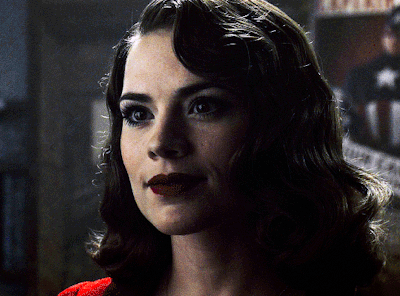
no channel mixer this time because the automatic curves option dealt with the yellowness, but you can see it made the gif too green. i needed to correct that with the following adjustment layers:
curves (automatic option) (gif 2) >> same curves layer (tweaks) (gif 3) >> brightness & contrast (gif 4) >> hue/saturation (tweaked cyan+blue+green) >> selective color >> color balance (gif 5) >> b&w gradient map >> (sepia) filter >> vibrance (gif 6)
i added a hue/saturation layer to remove the blues & greens before my selective color layer because i thought that was more urgent than tweaking the tint of all colors. color balance (gif 4) was the real hero here, though, by removing the green tint. the selective color layer was meant to make the red pop more than anything else, because the rest looked pretty good, especially her skin tone (despite the green tint). you can notice that tweaking the curves layer (small gif 3) also helped A LOT with the green problem.
tl;dr 😵💫😵💫😵💫
here's a list of my go-to's while coloring and lightning gifs. it's not a rule, just a guide. there are gifs in which i don't use all these adjustment layers, or use them in a different order. it all depends!
1. curves (automatic option + tweaks) 2. brightness & contrast 3. channel mixer 4. selective color 5. hue/saturation 6. color balance 7. b&w gradient map 8. color filter 9. vibrance
i'll suggest that you study each adjustment layer listed for more info, either with other Tumblr tutorials or YouTube ones. the YouTube ones focus on images, but you can translate what they teach to gif making very easily. you can ask me to further explain any adjustment layer, too! i was brief to keep this short (which i kinda failed lol).
feel free to ask me for clarification or something else about gifmaking wise, i always like to help. ❤️
#*#*tutorials#gifmaker tag#resources#resource: tutorials#ps help#uservivaldi#tuserjen#userrin#userelio#useralien#userzaynab#userchibi#userbuckleys#usertj#userbess#tuserlucie#useraljoscha#userdavid#usershreyu#usernolan#userhallie#userisaiah#tusergio#tusergeo#userjesslynn
795 notes
·
View notes
Text
Pick a Card: Career Guidance




Top Left to Right--> Pile 1, Pile 2
Bottom Left to Right--> Pile 3. Pile 4
If You Liked This Reading Sign up to TheObsidianPages777 Newsletter
+Free E-Guides on New Moon Manifestation and Gem Stone for Life Path
================================================================================================
Pile 1
Current Situation: The Chariot
You are determined and focused on your career goals, moving forward with purpose and direction. There's a sense of control and determination driving your actions.
Challenges: Five of Wands
You may be facing competition or conflict in your workplace. There could be differing opinions and struggles that make it hard to progress smoothly.
Advice: Strength
Rely on your inner strength and patience to navigate through challenges. Maintain self-control and approach conflicts with compassion and understanding. Your resilience will lead you to success.
Ideal Careers:
Leadership Roles: Positions such as a manager, director, or CEO, where determination and leadership are crucial.
Entrepreneur: Running your own business where you can harness your drive and overcome competition.
Project Management: Roles that require strong organizational skills and the ability to navigate conflicts and challenges.
Military or Law Enforcement: Careers that require discipline, determination, and the ability to handle conflict and stress.
Athletics or Coaching: Where physical and mental strength, as well as resilience, are important.
================================================================================================
Pile 2
Current Situation: The Hierophant
Your career path is currently influenced by traditional structures and conventional methods. You may be working within an established system or organization.
Challenges: Seven of Cups
There may be confusion or too many options available, making it difficult to choose the right path. Avoid getting lost in illusions or wishful thinking.
Advice: The Hermit
Take time for introspection and seek inner guidance. Reflect on your true goals and values before making decisions. Solitude and self-reflection will provide clarity.
Ideal Careers:
Education: Teacher, professor, or academic advisor, where traditional knowledge and guidance are valued.
Religious or Spiritual Leader: Priest, minister, or spiritual counselor, providing guidance within established belief systems.
Legal Profession: Lawyer, judge, or paralegal, working within the structures of the legal system.
Research and Academia: Careers that involve deep study and reflection, such as a researcher or academic.
Counseling or Therapy: Roles that require introspection and helping others find clarity, such as a therapist or counselor.
================================================================================================
Pile 3
Current Situation: Ace of Pentacles
A new opportunity or beginning in your career is emerging. This could be a job offer, a new project, or a chance to start something new with strong potential for growth.
Challenges: The Devil
Be wary of falling into negative patterns or becoming too attached to material success. Avoid temptations that could lead to unethical behavior or burnout.
Advice: Page of Swords
Approach new opportunities with curiosity and a willingness to learn. Stay vigilant and gather information before making decisions. Be clear and honest in your communication.
Ideal Careers:
Finance: Banker, financial advisor, or investment analyst, where new opportunities for growth are abundant.
Real Estate: Real estate agent or property manager, involving new ventures and potential for substantial growth.
Technology: IT specialist, software developer, or tech entrepreneur, where continuous learning and vigilance are key.
Journalism: Reporter, editor, or content creator, focusing on gathering and disseminating information.
Consulting: Business consultant or analyst, providing strategic advice and insights to businesses.
================================================================================================
Pile 4
Current Situation: Three of Cups
Collaboration and teamwork are currently significant in your career. You may be part of a supportive group or network, enjoying camaraderie and shared goals.
Challenges: Four of Pentacles
There could be a tendency to hold on too tightly to security or resources, leading to stagnation. Fear of change or loss may be preventing growth.
Advice: The Star
Stay hopeful and keep a positive outlook. Trust in the universe and your vision for the future. This is a time for healing, inspiration, and aligning with your true purpose.
Ideal Careers:
Event Planning: Event coordinator or wedding planner, where collaboration and teamwork are essential.
Human Resources: HR manager or recruiter, fostering a positive and collaborative workplace environment.
Creative Arts: Artist, musician, or performer, involving collaboration and shared creative goals.
Non-Profit or Community Work: Community organizer, social worker, or NGO worker, focusing on collective well-being and humanitarian goals.
Healthcare: Nurse, doctor, or therapist, providing care and support with a focus on healing and hope.
If You Liked This Reading Sign up to TheObsidianPages777 Newsletter
+Free E-Guides on New Moon Manifestation and Gem Stone for Life Path
#pick a card#pick a pile#pick a photo#pick one#tarot community#tarot reading#tarot#tarot cards#tarotblr#pick a picture#pick a reading
317 notes
·
View notes
Text
the passenger princess playlists

「 tws + notes: no tws, unedited, probably ooc, self-indulgent because we have fun here, author's taste in music is utter shit 」

「 gn!reader, can be platonic or romantic <3 」
↳ ft. these stupid parasites that keep infecting my brain aka bruce wayne,clark kent, jason todd, tim drake, and stephanie brown
author's note: THEY ARE THE PASSENGER PRINCESS!!!! WHY???? because if i projected my music taste on the reader insert we would have many issues. im not THAT self indulgent w/ my stuff i say, posting hcs of character's music tastes based on my own

you decide that it's time to show how much you trust them.
"hey," you mutter, eyes still on the road, fingers absentmindedly drumming on the wheel. "...you can have the aux cord, by the way."

▸ BRUCE doesn't even take it at first. he usually prefers to drive in complete silence himself, so he lets you handle the music. he's pretty nonchalant about what you play, indifferent to most music as long as it doesn't make his ears bleed.
the first time he takes the offer and plays something he personally enjoys, it's pretty straightforward: his main genres are classical, jazz, and dad rock. like... a lot of dad rock. he can read the room er, car?? well enough to know that the classical and jazz songs he listens to aren't exactly driving playlist material. and yes something in the way by nirvana will be played battison i fucking love you
BRUCE's songs include: ♡ she sells sanctuary by the cult ♡ something in the way by nirvana ♡ 1979 by the smashing pumpkins

▸ CLARK is more than happy to share his music! he's always been excited to hear whatever you jam out to and is pretty open to different genres. he definitely finds favorites of his that match the energy of your car playlists. doesn't wanna play anything that's too much of a bummer though, mainly because driving with you has such good vibes!!! he can't ruin that :( unless your in some sorta mood to be upset. then he's got some stuff aka a lot of elliot smith and jeff buckley
he finds a lot to love in all sorts of genres. it's a mix of stuff that he grew up listening to with his parents, stuff that he found on his own from artists he enjoys, and stuff you introduced him to. his music taste is just a mosaic of love for the people around him.
CLARK's songs include: ♡ it's been a long, long time by harry james and his orchestra ♡ cupid by sam cooke ♡ real love baby by father john misty

▸ if there's someone who's going to criticize music without sharing his full music taste? it's JASON. he's actually not mean but he'll make comments which give the impression that he thinks he'd be better with the aux. like bro ask for the aux normally. REMIND HIM WHO'S HOLDING THE WHEEL. YOU BETTER PRAY THAT THE VOTERS ARE IN YOUR FAVOUR WHEN WE DRIVE INTO THIS TELEPHONE POLE
when you give him the aux privileges he's secretly overjoyed. he likes a lot of different genres, rock, metal, indie rock, some punk... but don't ruin his mood by pointing out his music taste is vaguely inspired by bruce's. or make fun of him for listening to sleep token. obviously he likes listening to chill music too— but for a drive? it's gotta be loud and fast. secretly gets happy when you like the songs he plays. the validation gives him a quiet sort of joy.
JASON's songs include: ♡ knives out by radiohead ♡ goddamn these hands by the taxpayers ♡ custer by slipknot

▸ TIM is pretentious about music, but he doesn't intend to be. he's proud of his taste to the point where he's beyond spotify wrapped and stats.fm. i firmly believe he's made his own software to track the music he's listening to and it's thorough. that being said, he really doesn't mind listening to your music. he likes giving recommendations based off of the songs you play in the car.
tim adores branching out into different genres, and the more obscure it is, the more he likes it. given, he's also into some pretty known and loved bands. car seat headrest. radiohead. slaughter beach, dog. the minute you hand him the aux, he's trying to put you on his favourites. a lot of indie. like... so much indie. and midwest emo... american football WILL be played. he also unfortunately cannot hide his love for the pinkerton album.
TIM's songs include: ♡ never meant by american football ♡ oh! starving by car seat headrest ♡ tragic girl by weezer

▸ STEPHANIE is so cool. i've seen swiftie headcanons but guys... pop punk princess stephanie brown is too real. pop punk, alternative rock, riot grrrl— all that stuff. probably got aux privileges before you even gave her permission, she just started queuing up her songs with yours.
when she gets full control, she already has a playlist ready for the drive. it's kind of all over the place, but the vibes are great. you will go from mommy long legs to chappell roan and then to whatever recession pop artist she's into that week. steph is also a big fan of evanescence, kittie, and hole. those in specific are heavily headcanon-y but i feel like she'd appreciate them.
STEPHANIE's songs include: ♡ misery business by paramore ♡ cherry scented by jack off jill ♡ gimmie brains by bratmobile

▸ what are you listening to? you don't know but CASS seems happy at least. when you gave her aux privileges, she didn't really know what to do. she ended up just picking her favourite songs out of your usual playlists.
eventually, she gets excited by the prospect of sharing what she usually listens to and it's... something. so here's the thing: she listens to a lot of ambient noise. like, things that people usually sleep to. you once drove around for half an hour listening to nothing but the noises of rustling leaves and chirping birds through your speakers. and she was happy.
she listens to a lot of music where there's not a lot of lyrics most of the time, but tends to listen to some of stephanie's music as well— usually the more mellow side.
CASS' songs include: ♡ relaxing tranquil day in the forest by nature sounds ♡ healing ritual by whatever, dad ♡ to violet by adrianne lenker

part two... potentially??? lmk which character's you'd want ^_^

— reblogs always appreciated!

#dc#dc comics#dc x reader#dc x you#batman#superman#red hood#red robin#spoiler dc#black bat#bruce wayne#clark kent#jason todd#stephanie brown#cassandra cain#x reader#I WANTED TO ADD SO MANY MORE CHARACTERS AAUWGHWH
94 notes
·
View notes
Text
"Tails's Joke Corner: Part 2 – 200% More Chaos, 100% More Punchlines. Btw yes ididnot take much care on this thanthe lasttime technical issues
Why did Sonic start a podcast? Because he wanted to go live at the speed of sound.
Shadow tried therapy once… …but the therapist couldn’t handle the existential edge.
Rouge stole a Chaos Emerald and said: “Oops, my kleptomania’s acting up again.”
Tails built a mech that could fold laundry. It folded itself into depression.
Amy tried Tinder, but everyone swiped left. Except Sonic. He ran from the app.
Omega updated his firmware… Now he’s emotionally unstable and slightly British.
Knuckles locked his keys in the Master Emerald. The echidna tech support said: “Have you tried punching it?”
Sonic Frontiers glitch: Sonic fell off a boss and landed in Skyrim.
Shadow in Shadow Gems be like: “I am the ultimate bug report.”
Big the Cat got lost in Cyberspace. Froggy sent him a GPS pin.
Dr. Eggman created a dating sim. It only matched him with himself.
Tails installed Windows 98 on the Tornado. Now it runs slower than Classic Sonic.
Sonic ordered a chili dog. Shadow asked, “Is that your purpose?”
Shadow’s keyboard only has edge keys. Ctrl + Alt + Existential Crisis.
Silver came from the future just to say: “Bro, 06 still sucks.”
Amy has a hammer. Sonic has trauma.
Eggman tried creating a streaming service. It’s called Eggflix and only plays his TED Talks.
Chaos tried swimming in Gatorade. He evolved into an energy drink mascot.
Rouge infiltrated Area 51. Found Shadow’s original edgy design sketches.
Tails got stuck in Blender. Not the software. The kitchen appliance.
Shadow used Chaos Control to skip the tutorial. Now he doesn’t know how to play life.
Sonic forgot his rings. Shadow said, “You dropped your bling, faker.”
Blaze lit her stove with her fingers. The kitchen is gone now.
Knuckles downloaded Duolingo. He still can’t read ancient text.
Omega’s internal clock runs on doom energy.
Sonic Heroes but every team talks at once. “Sonic! Espio! Charmy! Eggman?!?”
Shadow Generations: The camera is your enemy.
Tails accidentally created ChatGPT. Now the Tornado argues with him.
Eggman made a clone of himself. He lost an argument to it.
Sonic got stuck on a wall. Knuckles asked, “You climbing or glitching?”
Amy’s hammer is Bluetooth now. It plays Spotify mid-swing.
Big became a Twitch streamer. Category: Just Froggin’.
Shadow’s motorcycle runs on trauma.
Tails modded Minecraft. It now runs in the Tornado’s cockpit.
Sonic tried sleeping. His dreams were just speedruns.
Knuckles’ dating profile: “Guardian of your heart. Punch first, ask later.”
Eggman’s mech broke. He rage quit and blamed lag.
Metal Sonic tried making toast. Set the house on fire with precision.
Sonic did a kickflip. Amy said: “Husband material.”
Shadow Generations glitch: “Camera said: I do not perceive you.”
Sonic blinked… And ended up in the ARK again.
Shadow joined a meditation group. He yelled “CHAOS CONTROL” in the first 5 minutes.
Tails tried yoga. Now he’s a pretzel with an IQ of 300.
Rouge wore stealth shoes. Still heard by Knuckles from 3 zones away.
Silver made a TikTok.
ITSTHENEARFUTURE
Eggman uses Microsoft Paint for schematics.
Blaze sneezed. The entire zone caught fire.
Knuckles found a riddle. Punched it. Problem solved.
Sonic Generations glitch: Sonic yeeted himself into the title screen.
Shadow said "Maria" so hard the game crashed.
Tails made a backup of Shadow’s memory. Now it’s just labeled “DO NOT OPEN – TOO MUCH EDGE.”
Shadow blinked in Shadow Gems… Game crashed out of fear.
Knuckles got a library card. Then punched the librarian for "being too mysterious."
Eggman tried stand-up comedy. The punchline exploded.
Sonic ran so fast, he entered another Sonic game. It was Sonic Boom. He immediately ran back.
Tails made a smart fridge. Now it lectures him about nutrition.
Amy joined a rock band. Her instrument? The hammer, obviously.
Omega tried painting. The canvas caught fire from rage.
Shadow sat in a therapist's chair. The chair disintegrated.
Sonic got a sponsorship deal. It was for anti-glitch spray. He refused.
Rouge tried yoga. She stole everyone’s mats.
Knuckles made a smoothie. He punched the fruit directly.
Shadow hacked the game code. He replaced all NPCs with himself.
Sonic found a bug in Shadow Gems. Shadow just called it a “feature.”
Tails asked ChatGPT for advice. Now he’s building a sarcasm bot.
Eggman joined Twitter. He blocked Sonic in real life.
Big the Cat wandered into Final Fortress. No one knows how. Not even Big.
Silver said “IT’S NO USE” at a coffee shop. Now he's banned for life.
Shadow downloaded Spotify. Every playlist is titled “Angst.”
Sonic tried ASMR. Too fast. The mic exploded.
Tails built a drone. It follows Shadow and whispers “edgy…”
Knuckles tried sushi. Punched the wasabi.
Amy wrote a fanfic. Sonic moved to another timeline.
Omega tried gardening. Now he grows C4.
Shadow entered cyberspace. The internet got emotional.
Sonic got invited to Smash. Shadow broke the door down asking “WHERE’S MY INVITE?!”
Tails made a Sonic AI. It speedran its own shutdown.
Eggman bought a Fitbit. Declared war on his step count.
Rouge got a diamond sponsorship. She stole the diamonds right after.
Sonic accidentally boosted into a mirror. Said “Sorry faker” to himself.
Knuckles started a podcast. Only one episode. It’s just grunting.
Shadow turned off motion blur. The game lost 90% of its style.
Tails programmed a meme bot. It only posts "Shadow = edgy" memes.
Silver tried therapy. Time travel made every session awkward.
Omega entered a rap battle. He dropped bars and missiles.
Big became a motivational speaker. His only advice: “Froggy.”
Shadow walked into a Hot Topic. Got hired on sight.
Sonic got a glitch where he turned into a car. Shadow drove him off a cliff for “justice.”
Rouge disguised herself as a Chaos Emerald. Knuckles fell for it.
Tails made an AI Sonic. It spent 3 hours saying “Gotta go fast.”
Eggman’s mech had a voice assistant. It refused to listen unless bribed with EggTokens.
Shadow stared into the void. The void blinked.
Knuckles tried a Rubik’s cube. Solved it with one punch.
Sonic made a cooking show. Every dish was chili dogs.
Silver said “It’s no use” to a vending machine. It worked.
Omega tried to join Instagram. Got banned for explosive selfies.
Amy went to therapy. The hammer got its own seat.
Tails accidentally opened the multiverse. Now there are 12 Sonics and a plumber.
Shadow tried journaling. It was just the word “darkness” 400 times.
Sonic met his alternate self. They raced. Time imploded.
(Btw there might be errors bc of autocorrect in the text like reblog this took me a whilee btw what shoud i do next theory or etc?)
#tails the fox#sonic the hedgehog#shadow the hedgehog#rouge the bat#knuckles the echidna#dr eggman#amy rose#silver the hedgehog#blaze the cat#big the cat#omega#sonic jokes#shadow gens#shadow generations#sonic memes#tails jokes#sonic tumblr#sonic glitch#sonic fandom#gaming memes#funny sonic#sonic humor#chaos emeralds#chaos control#chaos blast#glitchcore#glitch memes#hedgehog with attitude#sega#sega memes
23 notes
·
View notes
Note
I think you’re cool what art program do you use and do you recommend it?*
*I personally already have an art program I love to bits but I’m curious
lol I grew up poor, never really had computer access until I was about.... fifteen, seventeen? And it was a second-hand laptop, no mouse, no software.
Still haven't gotten a handle on any digital mediums, but I can do pretty much anything at all in physical media.
Favourite mediums are India ink, clay, linen, and Acrylic ♡♡♡
And I know pretty much every artist is expected to just know digital art these days, but like... I dunno, something just doesn't feel right when I can't see the tools I'm working with, you know? I can't touch the materials, or the textures, or smell or feel or build my own equipment and it's... unsettling, I think? Like..... Like losing all feeling in your fingers
Idk
159 notes
·
View notes
Note
Hope you work day is going alright!💞
A drop-in visit from PhD!Candidate Curtis on his way back to his apartment from the university. He’s gotta run some data analysis for his thesis, but has no idea where to start. Someone said you could help him find a way?

Sincerest thanks for your patience, Essie! My muse did not want to work on this for the longest time!
A/N: Reader is gender neutral. No physical descriptors used.
Warnings: college/university stress. You don't know pain until you see university students begging the printer to work faster during finals week.

Today seemed to be regular day at the reference desk. You were answering emails from the mathematics faculty and students, assuring them about library holdings of their requested materials. Sometimes directing them to the LaTeX to TeX converter you'd had to make, silently cursing MathSciNet and zbMath for not converting yet. Thankfully, the library students you were monitoring at the reference desk were able to handle most of the questions that got directed at them.
At least until a tall, very handsome man with a buzzcut, wearing sunglasses and a leather jacket walks in. You keep an eye on him as he approaches the desk because he doesn't look happy and you're not about to let anyone yell at the students. Thankfully he seems polite enough, neither of the students look scared, but they do direct him to you.
Making eye contact, you motion him over and he's quick to obey.
"How can I help?"
"I'm, I'm Curtis and...my, my data is...I think it got corrupted," he removes his sunglasses and he looks completely devastated. "I can't lose this data. It's, it's my thesis."
You nod in what you hope is a reassuring manner, "do you have a copy of the data in the university servers?"
He holds out a flash drive and you grab the laptop that's never allowed to connect to the network and get it ready. When it is you hold your hand out and he gives you the drive. Plugging it in you take a few minutes to figure out what you're looking at. Some of the terminology is familiar, he's clearly not a mathematics PhD, based on the labels you're able to discern.
"Oh, I see the problem," you tell Curtis, who's looks keep distracting you from your work. "You were, understandably, trying to use data you'd picked up using our Statistica license on your home computer that has the public domain Dataplot software."
"And I'm guessing the two are not interchangeable," Curtis sighs in defeat.
"Unfortunately the metadata schemas they use for the data sets don't work well together," you nod. "The data isn't corrupted, it's just very, very messy and it would take you a lot of late nights to clean it all up again, even if you knew R."
He scratches the back of his neck, "so my data is useless?"
"You have backups, right? You didn't just keep all your data on this flash drive, right?"
"I have backups," he nods. "But it's still months of work down the drain." He raises his hands to his face, looking like he wants to cry. It's a look you're painfully familiar with given your line of work.
You unplug the drive and hand it to him, "hey, look at me." He lowers his hands a little and the pain in his beautiful blue eyes breaks your heart. "You're going to be okay. Yes, it's a lot of time you'll never get back, but it's not the end. You're going to be able to kick this data's ass and get it in line because you know what you're doing with it now. Your thesis hit a setback, it happens a lot more than people would like to admit. You're not alone and you will be able to get this done."
He seems to take your words to heart, taking a few breaths and standing up straight.
"And make sure to get yourself a treat," you add. "You're hurting and you need to take care of yourself."
He almost smiles as he nods and walks out.
🔣🔣🔣🔣🔣🔣🔣🔣🔣🔣🔣🔣🔣🔣🔣🔣🔣🔣🔣🔣🔣🔣
It's been a few months and you'd almost forgotten about the poor PhD student. You probably would have had his physique not stood out so much. The same physique you see walking towards the reference desk, but with a giant smile. You smile in return, he must've gotten his data sorted out.
He walks up to you, "I don't know if you remember me--"
"Statistical software mess, right?"
He lowers his head as his cheeks develop a pink tint, "yeah."
"I'm guessing it all worked out?"
"I'm officially Dr. Everett, now."
Your smile grows, "congratulations, Doctor!"
"Thanks, um," he rubs the back of his neck. "If, if it's not too forward, could I take you out to dinner? As a thank you?" Your eyes go wide. "It wasn't just the data, software stuff that you helped me with. I was genuinely considering just dropping out, giving up. But then you looked me in the eyes and told me I could do it and...and I want to thank you for that."
Smiling, you tell him, "I get off at 6."

Tagging: @alicedopey; @delicatebarness; @icefrozendeadlyqueen; @ronearoundblindly
#zombie asks#curtis everett#college au#college student!curtis everett#librarian!reader#curtis everett x librarian!reader#curtis everett x reader#curtis everett imagine
62 notes
·
View notes
Text
Automation of Warehouse in pune | India
The process that involves little to no human intervention in the automatic movement of items into, out of, and around warehouses for consumers is referred to by this name. Warehouse automation goes by a number of names. By putting an automation project into place, a company can get rid of physically taxing tasks like repetitive data entry and analysis.
#Warehouse Automation Solutions#Material Handling Processes#Partner in Factory Automation#Electrical & software solutions#Process Automation Partner#Revolutionizing Process Automation#Transforming Automotive Manufacturing with Advanced
0 notes
Note
Ur soooo right abt Lance I think he just became the fandom’s darling because people saw inklings of insecurity and home sickness and zeroed in. He’s whump bait, but like without the more complicated issues tied into Shiro, Allura, and Keith’s problems. Prime projection material.
He has potential and I appreciate fandom’s ability to see that in him, but you’re so right that people have completely forgotten who he is in canon. He *could* have been better, but he wasn’t and it’s frustrating that people have lost sight of that because I think it would genuinely produce more interesting takes on his character and role in the story. As someone who genuinely wants him to be a better character it makes me want to eat dry wall.
Lance, first and foremost, is the everyday man. That's why he's so popular. He is far from a piloting prodigy, flirts with every pretty girl, funny and exaggerative, has a generic weapon like a rifle, is the first paladin to find his Lion, and has the most basic interal conflict there can be. Which is why everyone loves him.
Shiro? Shiro is confirmed gay, was hailed as the most promising pilot pre-canon, was officially the youngest man sent into space, but also had an illness for canon forgot about it, had major PTSD that left him unable to move in most cases, considered himself broken if his hallucinations said anything, and literally died. He's good leader matieral, able to handle a group of four wildly differing teenagers and only really let his emotions plan his course of action once (when Allura was kidnapped). This man is insanely skilled but also insanely traumatised.
Keith? Keith beat all of the records Shiro set and was known as a genius in the field, only held back by his defense mechanisms and rushing on ahead. He was abandoned by his mother when he was a toddle, then his father died implicitly before his eyes, he was then an orphan where he was probably passed around from family to family, ot feeding into his adandonment issues. He gained a friend in Shiro, the first person to reach out to him, and then lost him a few years later. He finally gets Shiro back, only for more shit to happen. He finds out his mom was Galra, and becomes sorry that he even existed because of this. Nobody on Voltron actually felt like his friend with Pidge constantly calling him a loner right after he lost Shiro, Hunk poking fun at his Galra genes, and Lance playing up this one-sidedly rivalry and taking everything he does as an attack on his person. He loses Shiro again and has to constantly give him up for the sake of Voltron and the universe. The only time he can focus on himself is when Shiro is back and he distants himself for the team's sake and they just let him go. He's so affected by grief before the story starts and it doesn't give him a break. Even so, he's so kind and genuine about everything. He becomes the Black Paladin, not because he had no choice. Maybe at first, but he grows into that role and becomes a great leader.
Pidge? Pidge is a prodigy and a genius, able to hack firm and software from alien planets. She can fly a jet just from reading instruction manuels and have little to no trouble. At the same time, lost her brother and father all at once. When she finally got some clue as to what happened to them, she was kicked out and banned from the Garrison. She disguised as a boy and snuck in, abandoning her dream of becoming a fighter pilot because navigation would teach her more about scanning space for extraterrestrial communication and lifeforms. When she finally has the chance to find her family, she has to constantly give them and clues she may find up because Volton and the universe come first.
Hunk? Hunk is just as much of a genius as Pidge, even if the writers forget, with him able to spot foul play on an alien ship easily. He's so kind and loving yet fierce with his protection and so strong when defending his friends. He keeps spirits high with his warming attitude, even if he's the most home sick of them all. He acts the most realistically to become a child soldier. Still, even when he's terrified, he pushes on so that people like Shay can find out what freedom is. Feel it for themselves. When they go back to Earth, Hunk is the only one who has to fight to get his parents back and earn his happy ending. He suffers throughout the series, but he's always looking at the greener side.
Allura and Coran? They lost their families and thejr entire species before canon ever began. They lost so much and have nothing but revenge fueling them. They have to deal with the fact that they slept through the massacre of the Altean species and woke up far too late. They have to deal with inexperienced humans who have no real attachment to the war. They have to deal with the fact that they are the last of the Alteans. And when it's finally revealed that there are more survivors, they have to deal with the fact that they're being farmed by Lotor/Honerva for their quintessence. Allura was so depressed in season eight after falling for Lotor then being used so thoroughly by him. Coran never got to say goodbye to Allura before she died. Despite this, they still fight with all they have, making sure nobody has to face the loss they've felt.
Lance? Um. He's insecure about his place in the team? I guess Veronica nearly died but she didn't so whatever... He did spend a lot of his time in the Garrison being compared to Keith... But he also spent time he could've used to better his skills to sneak out and flirt with girls or hit the arcade. Um... I guess...
Um. Yeah.
See, I always wonder how people see such angst potential in Lance, or even see him as an angsty character in general. They act as though he's suffered the most in canon when, in reality, he hasn't. He has the most generic troubles and, I guess, it's more relatable that way? People don't have to struggle to relate to PTSD or abandonment issues or identity issues or child soldiers or losing your entire species.
Insecurity? That's easy because everyone feels insecure.
Which is why Lance is so popular.
Don't get me wrong, I'm not saying this isn't valid. It sucks to feel insecure and doubt your every move. The only difference is how common Lance's issues are compared to everyone else. Because Lance is generic as hell, people love to vent through him.
Lance has a stable friendship group, is constantly given everything he wants, and even manages to destroy what has been the canon ship over decades (Kallura). He invented a rivalry with Keith, who didn't even know who he was when they met. Because of that, people either ship them for the 'rivals to lovers' trope or hate Keith and act as though Keith was bullying him. Shiro doesn't take Lance's side often because Lance's ideas are dangerous or reckless. He still tries to let him down gently, making logical arguments (see: Shiro explaining that Red is fire-resistant so Keith has to go to the BOM HQ). Oh, but he's not on Lance's side so the fandom decides he's an awful leader. As if they know what a good leader is. They think a good leader is someone who gets distracted by a pretty girl and blames everyone but himself.
The only thing not given to Lance on a silver platter is Black. Thank God. But because he wasn't given Black when he was given everything else, fandom decides that DreamWorks hates Lance and decides to argue that Lance was always destined to be the Black Paladin. Ignoring how Black's colour scheme was LITERALLY ON KEITH'S CLOTHES.
So. Yeah. He definitely has potential before DreamWorks just started rewarding him for breathing. The insecurity he has could have been a good way to develop his character. He could have become someone outside of Keith or Shiro's shadow. He didn't need a love interest to prosper, as proven by the fact that he never prospered in canon.
His potential was there, just ignored because the writers were allergic to complex characters, even to the smallest degree.
(They should have gotten the writers for Race to the Edge to do Voltron ugh)
#vld#voltron#voltron legendary defender#character analysis#lance mcclain#vld lance#voltron lance#anti lance mcclain#anti klance#anti lance#anti black paladin lance#anti bp lance
92 notes
·
View notes
Text
Simulation Assessment Model
Randomized Orb Value: G2Z4E11
Projection Test Type: C
History Proposal:
On the train, denizens take many forms. Dogs, rock people, paper cranes, giant pig babies, and more. Although all of them are artificial beings projected through orbs on a perpetual train, it is an unfortunate fact that denizens only live a "normal lifespan" for whatever they are created as. Corgis have an average lifespan of 14 years, and that is about as long as Atticus will live for example.
The Cat, however, is an outlier.
Well over a hundred and fifty years old - in human years, not cat years - her unusual longevity shows no signs of stopping anytime soon. While no official statements nor more episodes have been made to help shed light on the mystery, I would like to preface my theory with a bit of context:
One of the oldest traditions in software is what is known as a "Hello, World!" program. In total, this program instructs a computer to display a message similar to the titular "Hello, World!" Simple and succinct, it is one of if not the first program students of new programming languages learn how to code. And with its simplicity, "Hello, World!" can be used to ensure the code compilation software has been installed properly and that the operator is using it correctly.
Similarly famous and historic is the "Utah teapot." Coming from the world of 3D modeling and computer graphics, it possess features familiar to many simple teapots: a spout, a handle, and a curvy shape. Lacking a need for surface textures, capable of casting shadows on itself, and possessing a decently complex yet easy to make model, it has been regarded a "perfect self contained object to test the creation of three-dimensional images." Even with today's advanced technology, it is still regarded as an effective standard reference model for beginners and experimenters alike.
Moving into the burgeoning field of 3D printing, one can find "Benchy," as well as its upcoming replacement "Boaty." Respectively a boat and a bench, these two unofficial models have been growing in popularity over the years, often finding themselves among many people's first prints. Either on a newly set up 3D printer, or with a new 3D printing material one hasn't used before. Whether through measuring a Benchy/Boaty's dimensional accuracy, checking its surface quality, and observing other attributes like overhangs (or the lack thereof), they are shaping up to become the next "Hello, World!" and Utah teapot.
In other words, the latest in a line of near ubiquitous benchmark tests for assessing the performance of a system upon first use.
With that established, picture a staircase where each step is a level of technology. From mere software to virtual models to physical printed objects, a few more steps is all it takes to climb aboard the Train. Memory tapes that hold an immersive snapshot of a person's mindscape. Wormholes that can disintegrate and reassemble people across time and space. An unknown level of influence over an entire parallel reality of reflections with all its existentially terrifying implications.
Orb-generated pocket dimension environments and so many intelligent and thinking people as denizens.
Maybe the reason the Cat doesn't have a normal lifespan like other denizens is because she isn't a 'proper' denizen in the first place. After all, the aforementioned benchmark tests lack the extra bells and features the systems they evaluate are capable of making when pushed. The original Utah teapot model didn't even have a base. So it's not hard to imagine the train's denizen creation system might have forgone extraneous programming like an artificial 'normal lifespan' limitation while performing startup checks, way back when the train first came online.
Thus, my proposal is that the Cat had started out as a benchmark projection for non-lifespan-related test requirements. Maybe her template just lacks the "normal lifespan" programming, and/or the "normal lifespan" programming was tested with a different, unfortunate benchmark projection. Either way, she served her vital system evaluation purpose and then got set aside as a no-longer critical part of the train. From that rock bottom, she could only go up from there. With a life as long as hers and having seen as much of the train as she has, there's so many potential answers for how she eventually transformed into the French con artist kitty we know today.
Like, for example, her collecting of many 'things.' It may seem like that's simply the norm she’s settled into by the present, but Simon's comment about how "she's collecting again" suggests it is actually her slipping into a bad old habit. As though rampant collecting is a coping mechanism for something. While the guilt from leaving Simon behind would easily explain such regression in behavior, therein lies the question of where said behavior came from in the first place.
If you ask me, I cannot help but look at the train of thought that started this all: Samantha lacking the programmed lifespan denizens have due to being a test object. Aka an immortal amongst denizens who will one day die, passengers who either die on the train or eventually disembark, and even car environments that are affected by time in ways she isn't.
Certainly makes one think about her having once gotten close enough with Simon for her to tell him to call her "Samantha," but now emphasizes to everyone she meets to merely know her as "THE Cat"...
#infinity train#infinity train theory#infinity train headcanons#it#it theory#it headcanons#the cat#infinity train the cat#infinity train samantha#the orb value and test parts are just fun little flavor text I made up#though the fun part is contemplating a few backstory options:#if there are others like her that she knows/have history with#Samantha being the only one to ever be created#or if she's one of/the last of her kind after the others met a terrible fate
8 notes
·
View notes
Note
The body the corrupted core chose was one that kept it's original form, but allowed him much more mobility. A simple, deeply buried design that was attributed to someone named Keith Astor. The core had indicated to the AMA its location within the files of the large, mazelike systems Aperture ran on... And judging by the software inside the core, he had some knowledge of who had created the files.
It had been a visionary piece. Not all of the materials were even available to AMA... But of course, it likely did it's best. Recplacing and substituting wherever it couldn't do the exact job the schematics entailed.
And finally, the core was able to be released from the chamber on the plate, unsteady and barely calibrated. He leaned against the wall for balance, the optic in his head spinning and blinking slowly... He'd kept the main body of a core for his head, minus the limiting handles, and his body was a slightly modified version of the regular models of this time.. Though it was much more modular... Whoever had made it had done so with the ease of modifications in mind..
He felt as if he were biting his tongue, anxious to speak for fear it would still come out wrong.. He hadn't spoken a word of sense in decades, it was perhaps only fair that he were tense...
@adventuregunsphere
The A.M.A had looked over its work. The arm it had used was seemingly a bit tense itself as it tried to analyze what it had done. It was unable to be exact with the schematics provided to it, so it wasn't entirely happy with how it came out. It wasn't perfect.
Nevertheless, it tried to push this aside. It did its best with what it had. The parts for this model were outdated afterall...
[Please proceed with caution; calibration has not been sufficiently completed.]
It watched quietly afterward. What could it have done better? What substitutes should it have used that would have been closer to the original blueprint? What if its estimation caused any errors or discomfort? It would not know. Not until the problems were found. So it sat in unease, anticipating a major flaw.
113 notes
·
View notes
Text
Europe is under siege—not by armies but by supply chains and algorithms. Rare-earth minerals, advanced semiconductors, and critical artificial intelligence systems all increasingly lie in foreign hands. As the U.S.-China tech cold war escalates, U.S. President Donald Trump battles Europe’s attempt to regulate tech platforms, Russia manipulates energy flows, and the race for AI supremacy intensifies, Europe’s fragility is becoming painfully clear. For years, policymakers have warned about the continent’s reliance on foreign technology. Those alarms seemed abstract—until now.
Geopolitical flashpoints, from the Dutch lithography firm ASML’s entanglement in the U.S.-China chip war to Ukraine’s need for foreign satellite services, reveal just how precarious Europe’s digital dependence really is. If Europe doesn’t lock down its technological future, it risks becoming hostage to outside powers and compromising its core values.
Fragmented measures aren’t enough. A European Chips Act here, a half-implemented cloud or AI initiative there won’t fix a system where every layer—from raw materials to software—depends on someone else. Recent AI breakthroughs show that whoever controls the stack—digital infrastructure organized into a system of interconnected layers—controls the future.
The U.S. government ties AI research to proprietary chips and data centers through its Stargate program, while China’s DeepSeek masters the entire supply chain at lower costs. Europe can’t keep treating chips, supercomputing, and telecommunication as discrete domains; it needs a unifying vision inspired by digital autonomy and a grasp of the power dynamics shaping the global supply chain.
Without a coherent strategy, the continent will be a mere spectator in the biggest contest of the 21st century: Who controls the digital infrastructure that powers everything from missiles to hospitals?
The answer is the EuroStack—a bold plan to rebuild Europe’s tech backbone layer by layer, with the same urgency once devoted to steel, coal, and oil. That will require a decisive mobilization that treats chips, data, and AI as strategic resources. Europe still has time to act—but that window is closing. Our proposed EuroStack offers a holistic approach that tackles risks at every level of digital infrastructure and amplifies the continent’s strengths.
The EuroStack comprises seven interconnected layers: critical raw materials, chips, networks, the Internet of Things, cloud infrastructure, software platforms, and finally data and AI.
Every microchip, battery, and satellite begins with raw materials—lithium, cobalt, rare-earth metals—that Europe doesn’t control. China commands 60-80 percent of global rare-earth production, while Russia weaponizes gas pipelines. Europe’s green and digital transitions will collapse without secure access to these resources. Beijing’s recent export restrictions on gallium and germanium, both critical for semiconductors, served as a stark wake-up call.
To survive, Europe must forge strategic alliances with resource-rich nations such as Namibia and Chile, invest in recycling technologies, and build mineral stockpiles modeled on its strategic oil reserves. However, this strategy will need to steer clear of subsidizing conflict or profiting from war-driven minerals, as seen in the tensions between Rwanda and the Democratic Republic of the Congo and the latter’s criminal complaints against Apple in Europe—demonstrating how resource struggles can intensify regional instability.
Above this resource base lies the silicon layer, where chips are designed, produced, and integrated. Semiconductors are today’s geopolitical currency, yet Europe’s share of global chip production has dwindled to just 9 percent. U.S. giants such as Intel and Nvidia dominate design, while Asia’s Samsung and TSMC handle most of the manufacturing. Even ASML, Europe’s crown jewel in lithography, finds itself caught in the crossfire of the U.S.-China chip war.
Although ASML dominates the global market for the machines that produce chips, Washington is using its control over critical components and China over raw materials to put pressure on the company. To regain control, Europe must double down on its strengths in automotive, industrial, and health care chipsets. Building pan-European foundries in hubs such as Dresden, Germany, and the Dutch city of Eindhoven—backed by a 100 billion euro sovereign tech fund—could challenge the U.S. CHIPS and Science Act and restore Europe’s foothold.
Next comes connectivity, the digital networks that underpin everything else. When Russian tanks rolled into Ukraine, Kyiv’s generals relied on Starlink—a U.S. satellite system—to coordinate defenses. And U.S. negotiators last month suggested cutting access if no deal were made on Ukrainian resources. Europe’s own Iris2 network remains behind schedule, leaving the European Union vulnerable if strategic interests clash.
Meanwhile, China’s Huawei still dominates 5G infrastructure, with Ericsson and Nokia operating at roughly half its size. Italian Prime Minister Giorgia Meloni has even floated buying Starlink coverage, underscoring how urgent it is for Europe to accelerate Iris2, develop secure 6G, and mandate a “Buy European” policy for critical infrastructure.
A key but often overlooked battleground is the Internet of Things, or IoT. Chinese drones, U.S. sensors, and foreign-controlled industrial platforms threaten to seize control of ports, power grids, and factories. Yet Europe’s engineering prowess in robotics offers a lifeline—if it pivots from consumer gadgets to industrial applications. By harnessing this expertise, Europe can develop secure, homegrown IoT solutions for critical infrastructure, ensuring that smart cities and energy grids are built on robust European standards and safeguarded against cyberattacks.
Then there is the cloud, where data is stored, processed, and mined to train next-generation algorithms. Three U.S. giants—Amazon, Microsoft, and Google—dominate roughly 70 percent of the global market. The EU’s Gaia-X project attempted to forge a European alternative, but traction has been limited.
Still, the lesson from DeepSeek is clear: Controlling data centers and optimizing infrastructure can revolutionize AI innovation. Europe must push for its own sovereign cloud environment—perhaps through decentralized, interoperable clouds that undercut the scale advantage of Big Tech—optimized for privacy and sustainability. Otherwise, European hospitals, banks, and cities will be forced to rent server space in Virginia or Shanghai.
A sovereign cloud is more than a mere repository of data; it represents an ecosystem built on decentralization, interoperability, and stringent privacy and data protection standards, with client data processed and stored in Europe.
Gaia-X faltered due to a lack of unified vision, political commitment, and sufficient scale. To achieve true technological sovereignty, Europe must challenge the monopolistic dominance of global tech giants by ensuring that sensitive information remains within its borders and adheres to robust regulatory frameworks.
When it comes to software, Europe runs on U.S. code. Microsoft Windows powers its offices, Google’s Android runs its phones, and SAP—once a European champion—now relies heavily on U.S. cloud giants. Aside from pockets of strength at companies such as SAP and Dassault Systèmes, Europe’s software ecosystem remains marginal. Open-source software offers an escape hatch but only if Europe invests in it aggressively.
Over time, strategic procurement and robust investments could loosen U.S. Big Tech’s grip. A top priority should be a Europe-wide, privacy-preserving digital identity system—integrated with the digital euro—to protect monetary sovereignty and curb crypto-fueled volatility. Piece by piece, Europe can replace proprietary lock-in with democratic tools.
Finally, there is AI and data, the layer where new value is being generated at breakneck speed. While the United States and China have seized an early lead via OpenAI, Anthropic, and DeepSeek, the field remains open. Europe boasts world-class supercomputing centers and strong AI research, yet it struggles to translate these into scalable ventures. The solution? “AI factories”—public-private hubs that link Europe’s strengths in health care, climate science, and advanced manufacturing.
Europeans could train AI to predict wildfires, not chase ad clicks, and license algorithms under ethical frameworks, not exploitative corporate terms. Rather than only mimicking ChatGPT, Europe should fund AI for societal challenges through important projects of common European interest, double down on high-performance computing infrastructure, and build data commons that reflect core democratic values—privacy, transparency, and human dignity.
The EuroStack isn’t about isolationism; it’s a bold assertion of European sovereignty. A sovereign tech fund of at least 100 billion euros—modeled on Europe’s pandemic recovery drive—could spark cross-border innovation and empower EU industries to shape their own destiny. And a Buy European procurement act would turn public purchasing into a tool for strategic autonomy.
This act could go beyond traditional mandates, championing ethical, homegrown technology by setting forward-thinking criteria that strengthen every link in Europe’s digital ecosystem—from chips and cloud infrastructures to AI and IoT sensors. European chips would be engineered for sovereign cloud systems, AI would be trained on European data, and IoT devices would integrate seamlessly with European satellites. This integrated approach could break the cycle of dependency on foreign suppliers.
This isn’t about shutting out global players; it’s about creating a sophisticated, multidimensional policy tool that champions European priorities. In doing so, Europe can secure its technological future and assert its strategic autonomy in a rapidly evolving global order.
Critics argue that the difference in mindset between Silicon Valley and Brussels is an obstacle, especially the bureaucratic nature of the EU and its focus on regulation. But other countries known for bureaucracy—such as India, China, and South Korea—have achieved homegrown digital technology from a much lower technological base than the EU. Indeed, through targeted industrial policies and massive investments, South Korea has become a world leader in the layers of chips and IoT. The EU currently already has a strong technological base with companies such as ASML, Nokia, and Ericsson.
European overregulation is not the issue; the real problem is a lack of focus and investment. Until now, the EU has never fully committed to a common digital industrial policy that would allow it to innovate on its own terms. Former European Central Bank President Mario Draghi’s recent report on EU competitiveness—which calls for halting further regulation in favor of massive investments—and incoming German Chancellor Friedrich Merz’s bold debt reforms signal a much-needed shift in mindset within the EU.
In the same spirit, Commission President Ursula von der Leyen has launched a defense package providing up to 800 billion euros to boost Europe’s industrial and technological sovereignty that could finally align ambition with strategic autonomy.
If digital autonomy isn’t at the forefront of these broader defense and infrastructure strategies, Europe risks missing its last best chance to chart an independent course on the global stage.
To secure its future, Europe must adopt a Buy European act for defense and critical digital infrastructures and implement a European Sovereign Tech Agency in the model of the U.S. Defense Advanced Research Projects Agency—one that drives strategic investments, spearheads AI development, and fosters disruptive innovation while shaping a forward-looking industrial policy across the EU.
The path forward requires ensuring that investments in semiconductors, networks, and AI reinforce one another, keeping critical technologies—chips, connectivity, and data processing—firmly under the EU’s control to prevent foreign interests from pulling the plug when geopolitics shift.
Europe’s relative decline once seemed tolerable when these risks felt hypothetical, but real-world events—from undersea cable sabotage to wartime reliance on foreign satellite constellations—have exposed the EU’s fragility.
If leaders fail to seize this moment, they will cede control to external techno-powers with little incentive to respect Europe’s needs or ideals. Once this window closes, catching up—or even keeping pace—will be nearly impossible.
The EuroStack represents Europe’s last best chance to shape its own destiny: Build it, or become a digital colony.
8 notes
·
View notes
Text
From Design to Deployment: How Switchgear Systems Are Built

In the modern world of electrical engineering, switchgear systems play a critical role in ensuring the safe distribution and control of electrical power. From substations and factories to commercial buildings and critical infrastructure, switchgear is the silent guardian that protects equipment, ensures safety, and minimizes power failures.
But have you ever wondered what goes on behind the scenes, from the idea to the actual installation? Let’s dive into the full journey — from design to deployment — of how a switchgear system is built.
Step 1: Requirement Analysis and Load Study
Every switchgear project begins with requirement analysis. This includes:
Understanding the electrical load requirements
Calculating voltage levels, short-circuit ratings, and operating current
Identifying environmental conditions: indoor, outdoor, temperature, humidity
Reviewing applicable industry standards like IEC, ANSI, or DEWA regulations (especially in UAE)
This stage helps engineers determine whether the project needs low voltage (LV), medium voltage (MV), or high voltage (HV) switchgear.
Step 2: Conceptual Design & Engineering
Once the requirements are clear, the conceptual design begins.
Selection of switchgear type (air insulated, gas insulated, metal-enclosed, metal-clad, etc.)
Deciding on protection devices: MCCBs, ACBs, relays, CTs, VTs, and fuses
Creating single-line diagrams (SLDs) and layout drawings
Choosing the busbar material (copper or aluminum), insulation type, and earthing arrangements
Software like AutoCAD, EPLAN, and ETAP are commonly used for precise engineering drawings and simulations.
Step 3: Manufacturing & Fabrication
This is where the physical structure comes to life.
Sheet metal is cut, punched, and bent to form the panel enclosures
Powder coating or galvanizing is done for corrosion protection
Assembly of circuit breakers, contactors, protection relays, meters, etc.
Internal wiring is installed according to the schematic
Every switchgear panel is built with precision and must undergo quality control checks at each stage.
Step 4: Factory Testing (FAT)
Before deployment, every switchgear unit undergoes Factory Acceptance Testing (FAT) to ensure it meets technical and safety standards.
Typical FAT includes:
High-voltage insulation testing
Continuity and phase sequence testing
Functionality check of all protection relays and interlocks
Mechanical operations of breakers and switches
Thermal imaging to detect hotspots
Only after passing FAT, the switchgear is cleared for shipping.
Step 5: Transportation & Site Installation
Transportation must be handled with care to avoid damage to components. At the site:
Panels are unloaded and moved to their final location
Cabling and bus duct connections are established
Earthing systems are connected
Environmental sealing is done if installed outdoors or in dusty environments
Step 6: Commissioning & Site Acceptance Testing (SAT)
This final stage ensures the switchgear is ready for live operation.
Final checks and Site Acceptance Tests (SAT) are performed
System integration is tested with other components like transformers, UPS, and generators
Load tests and trial runs are conducted
Commissioning report is generated, and documentation is handed over to the client
Conclusion
From idea to execution, the journey of building a switchgear system is highly technical, safety-driven, and precision-based. Whether you’re in power generation, industrial automation, or commercial construction, understanding this process ensures you choose the right system for your needs.
7 notes
·
View notes
Text
Surveying Spain: Working with Spanish Civil War Posters at NYU Libraries

Hi, my name is Mia Lindenburg. I am a graduate student undergoing NYU’s Dual Degree program, where I will get an MA in literature and an MLIS. This semester, I have been working with NYU’s Barbara Goldsmith Preservation & Conservation Department, mentored by Lindsey Tyne (Conservation Librarian), Laura McCann (Director of Preservation), Weatherly Stephan (Head of Archival Collections Management), and Felix Esquivel (Collections Manager, Special Collections), to survey the Spanish Civil War Poster Collection (ALBA.GRAPHICS.001). This internship has helped me to prepare for a future career in special collections libraries, where I will be required to work with delicate material similar to what I see in this collection. I am very thankful for this opportunity and how it has allowed me to delve deeper into archival work with a hands-on approach.
In addition to working with the Preservation department, I have been lucky enough to work with the Archival Collections Management (ACM) and Special Collections departments, allowing me to see the different perspectives of handling a large and often complicated collection. This blog post will demonstrate the different ways in which these departments added to my learning experience and show some of the special facets of working with this collection in particular.
BUILDING THE DATABASE
Before I began surveying this collection, I had to create an infrastructure that would allow me to compile the data I would be collecting. I used the software AirTable to build this database. First, I had to move the data that had already been collected into my table. This came from Archives Space (AS), an archives information management software used by NYU Libraries. This had much of the preliminary data I would need to fact-check against in the survey, such as poster locations. After I had brought the AS data into the table, I created fields that would duplicate the AS fields but with the descriptor (survey) to show any differences. Additionally, I made new fields for things we might want to consider, such as condition and size.
UNIQUE POSTER FORMATS
“I tu? Que fas per la victoria?”

ALBA-ES 46, copy 4 “i tu?” (Photo by: M. Lindenburg)
The first set of posters that I want to discuss is ALBA-ES 45 and 46, also known as the two sides of “I tu? Que fas per la victoria?” a Catalan poster depicting a bloody soldier advocating for his audience to participate in the war, to support the cause. This collection has many copies, encapsulated (meaning this poster is inside a protective mylar sleeve) and unencapsulated, of this poster. The copies pictured below interest me because they were particularly delicate. You can tell from the photos that they were split into pieces, making flipping the posters to inspect the back difficult. These will need a lot of conservation work, although they may not be an immediate priority since so many copies are in fine condition.
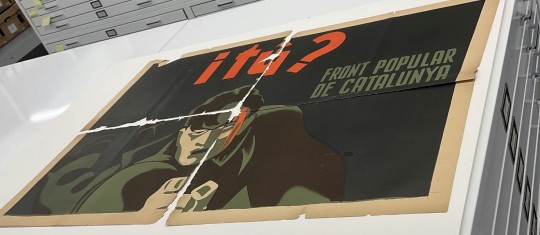
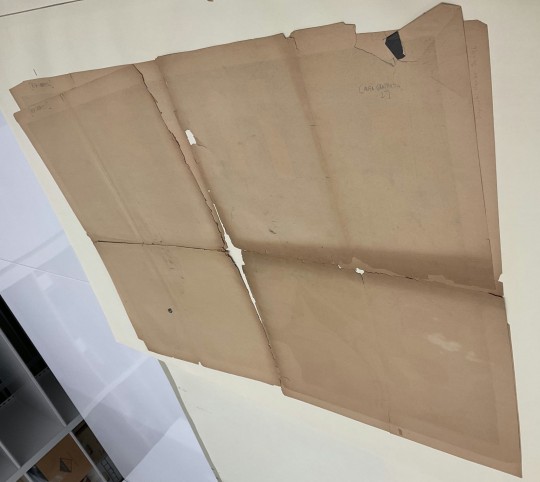
ALBA-ES 45, copy 4 “i tu?” (Photos by: M. Lindenburg)
“Allisteu-vos a les milicies antifeixistes”
The poster “Allisteu-vos a les milicies antifeixistes,” belongs to a series of posters collected at The Franklin Institute in Philadelphia as part of a circulating exhibit.
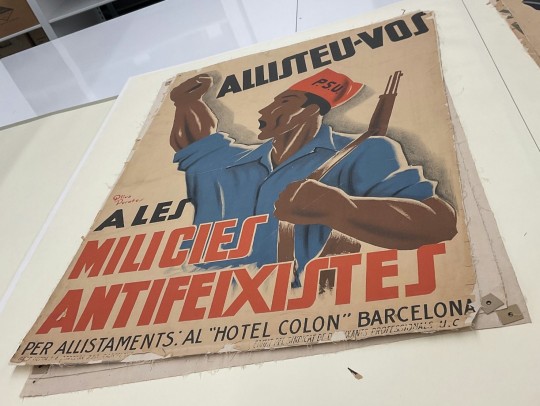
ALBA-ES 116, recto, “Allisteu-vos a les milicies antifeixistes” (Photo by: M. Lindenburg)
These interest me because of how they were mounted for the exhibition. Rather than encapsulating the posters or leaving them untouched, this exhibitor chose to attach muslin across the back and use cardboard and grommets to hang them.
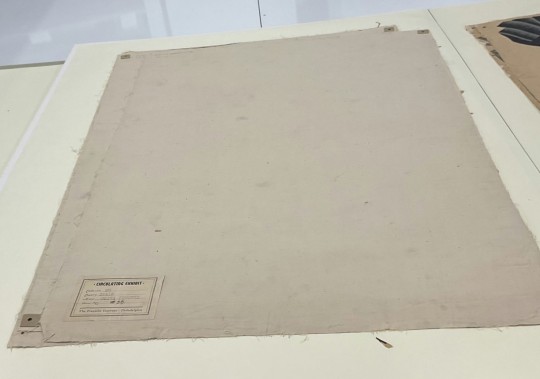
ALBA-ES 116, verso, “Allisteu-vos a les milicies antifeixistes” (Photo by: M. Lindenburg)
Annual Xmas Eve Ball
Poster ALBA-US-15, uses a mounting technique commonly used with posters associated with the Veterans of the Abraham Lincoln Brigade (VALB).
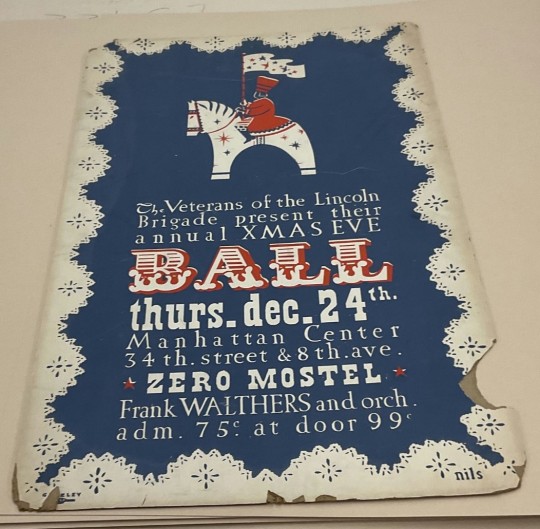
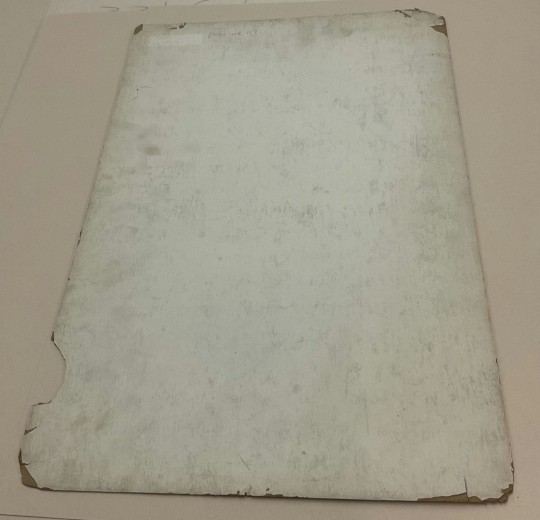
ALBA-US-15 (Photo by: M. Lindenburg)
It is mounted on a paperboard, which makes it somewhat heavy and unwieldy when grouped in folders. Take note of the headline of Zero Mostel, which shows the support the VALB received, even from celebrities.
THE INSCRIBED NAMES & WHO THEY WERE
Archie Brown is a signature I’ve encountered a lot in this collection.

ALBA-ES-8 (Photo by: M. Lindenburg)
Brown was born in 1911 in Sioux City, Iowa. He was brought into the world of labor activism at an early age. 1934, he was arrested at a Young Communist League (YCL) event in San Pedro. But he continued with his activism despite this. In 1937, Brown got tuned into the struggles in Spain, particularly after his brother was recruited to the International Brigade. In San Francisco, Brown was denied a passport because of his radical reputation. So, he went to New York City and stowed away on a ship to France, where he would travel to Spain. He joined the forces of the Abraham Lincoln Brigade and, even after the war, continued to fight as a soldier and an activist.

Archie Brown, 1982 (Photo by: R. Bermack). Image Source.
Harry Hakam is an interesting character, partially because of his frequent correspondence with other members of the Abraham Lincoln Brigade.
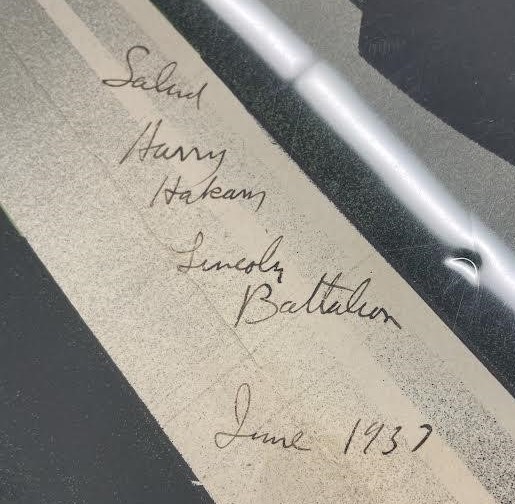
ALBA-ES-77 (Photo by: M. Lindenburg)
Hakam was born in Brooklyn in 1913. In February 1937, he sailed to France, arriving in Spain in March of the same year. He served primarily as a battalion runner, returning to the US in 1938. However, it’s his correspondence that makes him shine. His collection marker (Hakam) is found on many posters that share others’ names, meaning he likely sent these posters back and forth between fellow members.

Harry Hakam. Image Source.
We don’t have as much information on Al Erdberg, but we do know from the Harry Hakam Papers (ALBA.046) and the fact that Erdberg shows up in the Hakam posters that they had correspondence. Erdberg was likely part of the Abraham Lincoln Brigade or a state-side supporter. This would be an interesting figure to research further.

ALBA-ES-30 (Photo by: M. Lindenburg)
REHOUSING
A big problem I encountered when surveying these posters was with the housing rather than the posters themselves. Often, I encountered groups of ten or more posters in a folder, making the folder heavy and difficult to move. Further, if these posters are in mylar encapsulation, they become even heavier. To remedy this, the posters need to be rehoused into sturdier folders. I began some of this work with Laura McCann this semester, and the rehousing of the posters will continue through the summer.
VELCRO STICKERS
Some of the posters I found had velcro stickers left on the mylar encapsulation. These are likely from previous exhibition techniques, where the posters were attached to a wall using velcro. However, this technique is now deemed problematic, so Lindsey Tyne and I used a process to remove these stickers. We used a hot iron to heat small metal spatulas, which we then used to melt the adhesive of the sticker and lift the velcro off. This is a delicate process, but we got into a rhythm and moved fairly quickly.
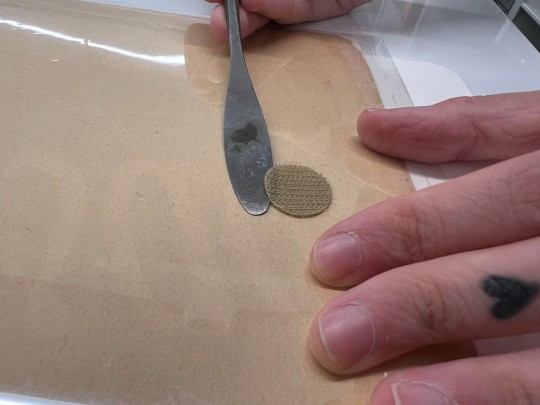
Mia removing velcro (Photo by: L. Tyne)
This collection has taught me many things. I have learned to be patient, think carefully, and always be on the lookout for new observations, among many other smaller skills. If I were asked to advise someone starting a similar project, I encourage them to take note of their natural rhythm so that they can figure out which order of surveying works best for them to maximize efficiency. I would also tell them not to be afraid of asking questions, even if it’s clarifying something they think you already know. This has been an incredible experience, and I feel so lucky to have been a part of this collection. Thank you for taking the time to read my post!
#nyulibraries#nyuspecialcollections#libraryconservation#paperconservation#librarypreservation#preservingthepast
28 notes
·
View notes